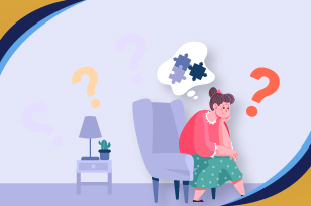Anxiety is a common feeling, like other emotions in human nature. Sometimes it can trigger physical symptoms, such as trembling, sweating, and a fast heartbeat. This is a fear of certain situations, events, or panics that a person feels in specific situations. When anxiety becomes persistent, it turns into an anxiety disorder.
Anxiety disorder is a category of mental health conditions that includes excessive restlessness, worry, fear, and nervousness. This condition affects people’s quality of life, but this is curable.
You are not alone in feeling this way. Shockingly, 19.1% of U.S. adults experienced anxiety disorders in the past year alone, according to the National Institute of Mental Health (NIMH). Only 36.9% of people get treatment.
This is not just a number, it represents millions of individuals who are facing daily challenges with an added layer of internal struggle.

What Exactly Is Anxiety, And What Are Its Levels?
Anxiety is a natural stress response to different threats that the mind predicts. When a person feels fear, it triggers the response of body, known as fight, flight, or freeze. It is a feeling of fear or apprehension about what’s to come. You can say that this is a natural alarm system that is designed to keep you safe from perceived threats. This feeling can involve bodily sources, like cognitive, or behavioral, like increased heart rate or fast breathing.
Read More: Can Anxiety Disorder Cause High Blood Pressure? Insights About The Connection
But this response does not only come with certain fears or dangers; people also feel anxiety in certain situations that are not dangerous, such as important events, decisions, public speaking, and social situations.
Feeling anxious does not mean that a person has a mental disorder, but this situation can vary from person to person and from time to time.
Levels Of Anxiety
Here are the categorized stages of anxiety to help you understand when to seek medical assistance.
Level 1- Mild Anxiety
Characteristics: This is a baseline, and often beneficial anxiety as it prepares a person for things like studying to prepare for a test, or paying bills before the late fees kick in.
Physical manifestation: it can bring a slight increase in heart rate before a challenge, or a fleeting knot in your stomach. The situation is minimal or barely noticeable.
Impact on life: Minimal to none. It often enhances focus and performance.
Level 2: Moderate Anxiety
Characteristics: At this level, anxiety becomes more noticeable and persistent. You might feel yourself worrying more frequently, even about everyday situations. While still manageable, it can start to feel uncomfortable.
Physical expression: More noticeable physical symptoms like restlessness, difficulty in relaxing, occasional headaches, or minor sleep disturbances.
Impact on life: It may cause some disturbance, but it does not influence daily functioning. You can avoid certain social situations or procrastinate more.
Level 3: Significant Anxiety
Characteristics: Here, anxiety becomes a normal force that greatly affects one’s thoughts, emotions, and behaviors. It can be irresistible and difficult to control.
Physical symptoms: this anxiety level gives frequent and intense physical symptoms such as panic attacks, chronic muscle tension, digestive issues, fatigue, and prominent sleep disturbances.
Impact on life: a person can face significant impairment in daily life functioning, like relationships, work, school, and personal well-being. You might avoid situations that trigger anxiety entirely.
Level 4: Severe or Generalized anxiety disorder (GAD)
Characteristics: This level represents the highest level of anxiety that is often debilitating, causing a person to find it nearly impossible to function in daily life. It is characterized by extreme distress and a profound sense of helplessness.
Physical symptoms: It comes with severe and constant physical symptoms that can stimulate serious medical conditions and lead a person to frequent visits to emergency rooms. Here, complete exhaustion is common.
Impact on life: severe impairment across all domains in life. You might feel unable to work, attend school, or maintain a relationship. This often indicates a severe anxiety disorder that requires immediate attention.
Read More: Generalized anxiety vs panic disorder: A Closer Look
Note:
It is important to remember that this is a simplified framework to learn about the anxiety levels and find yourself in them. This is also important for when to get treatment, or know about the anxiety recovery stages if it falls into the “significant” or “severe” categories.
Types of Anxiety According To DSM-5-TR
Generalized anxiety disorder (GAD)
The Diagnostic and Statistical Manual of Mental Disorders (DSM-5-TR) discusses some different anxiety conditions. However, in earlier editions, it discussed obsessive-compulsive disorder (OCD), post-traumatic stress disorder (PTSD), and acute stress disorder.
A person is GAD can have obstinate, pervasive feelings or may not have a specific focus. It is a stressful situation that then goes away after it is over, but this is a general feeling of worry that can influence many spheres of people’s everyday lives.
They can fear about lots of things and find it difficult to reduce or get proper sleep.
Panic Disorder
People with the worst type of panic attack have specific past experiences that trigger anxiety. The people can have precise anxiety triggers to a known cause, or they may not have a known cause.
Read More: Let’s Talk About Agoraphobia Treatment
Specific Phobia
Specific phobia is a fear of an object, event, or situation, such as height, water, animals, or any other thing. Unlike other anxiety disorders, phobia consists of one typical trigger.
People with a phobia might know their fear is unreasonable or life-threatening, but they can’t help control the situation.
Agoraphobia
This is a phobia or fear of avoidance of places, events, and situations from which it is difficult to escape, and where help would not be available.
People often misjudge this condition as a phobia of open space or the outdoors, but this is not. Some common situations where an agoraphobic person may be feared of:
- Use of the elevator
- Public transport
- Leaving home
- Height
Social Anxiety Disorder
Social anxiety is a fear of people’s negative judgment. A person with social anxiety may feel that people are evaluating everything they do, have low confidence, problems communicating. On the other hand, they feel uncomfortable or humiliated if they interact with people.
Other signs of social anxiety can be:
- Extreme self-consciousness
- Difficulty in eye contact
- Talking in an extremely low or soft voice
- Brain fog
Read More: Social Anxiety Disorder Treatment: What To Know?
Selective Mutism
Some kids might face this form of anxiety in which they cannot speak in certain events, before people, places, even though they can do so.
Neurosciences Behind Anxiety
Understanding the “why” of anxiety can help cope with it. It’s not “all in your head” in an indifferent way, it is exactly in your brain. Medical science has conducted significant studies and research in understanding the neurobiology of anxiety.
In the center of the brain, lies the amygdala, a small almond shaped structure. It’s basically your brain’s alarm bell, which is responsible for processing emotions, mainly fear. When it foresees a threat, the amygdala springs into action and activates the “fight or flight” response.
However, in individuals with anxiety, this alarm system can become overactive or misfire. Sometimes, the amygdala might sense non-threatening situations as dangerous, which leads to an exaggerated fear response.
Read More: Relationship Anxiety And Methods To Deal With It
Other Than The Amygdala, Brain Key Players For Anxiety
Prefrontal cortex:
This is the executive control center of the human brain that is responsible for reasoning, planning, and decision-making. In anxiety, the prefrontal cortex may have difficulty regulating the amygdala’s fear response, which leads to persistent worry.
Neurotransmitters:
These are chemical messengers in your brain.
- Serotonin: This is often related to mood regulation, sleep, and appetite. Imbalances in serotonin are frequently linked to anxiety and depression. Medicines like Selective Serotonin Reuptake Inhibitors (SSRIs) work by increasing serotonin levels in the brain.
- GABA (Gamma-Aminobutyric Acid): This is an inhibitory neurotransmitter, which means that it calms neural activity. Low levels of GABA are related to enhanced anxiety and panic.
- Norepinephrine: This neurotransmitter is involved in alertness and the “fight or flight” response. Overactivity of norepinephrine can add to symptoms like a racing heart and increased alertness.
Practical Treatments For Anxiety Disorder
Anxiety disorder treatment can consist of medication, therapy, or both.
Self Help
Sometimes a person can ease anxiety himself, but this is only possible at the first level, where it can be effective for mild or short-term anxiety. Things that can help people with anxiety include:
- Relaxing
- Exercise
- Healthy sleep routine
- Reduce caffeine
- Expressing feelings with the close one
Psychotherapy
A first-line treatment for severe anxiety is psychotherapy. There are many types of therapy that help people understand the situation, thoughts, beliefs, or experiences that can contribute to coping with anxiety. Some therapies include:
- Cognitive Behavioral Therapy
- Acceptance and commitment therapy
- Psychodynamic therapy
- Exposure therapy
Medications
Some medicines can reduce the anxiety symptoms that make the condition more manageable. Some people take medication to reduce the disorder and make it more manageable to begin therapy.
Read More: Let’s Talk About The Relationship Between ADHD and Anxiety
Get Help To Find Inner Peace
If you find that anxiety is disturbing your daily life, then it’s time to search for help. This could be when signs become powerful or cause major distress.
Your understanding of anxiety levels is not about labeling yourself as having a disorder, but it’s about gaining a deeper insight into your internal experience. It’s about recognizing that anxiety is a powerful force and can be treated.
Reach out to a healthcare provider who can better understand your situation and help you mitigate or reduce the symptoms. They can guide you towards proper resources and give you treatment options. Understanding the different levels of anxiety disorder is the first step towm ards a healthy mind. Orange Coast Psychiatry wants to help you in the stages of anxiety recovery, with specialized psychiatrists and practitioners. Learn more about our treatment options for anxiety or any other mental disorders.



















